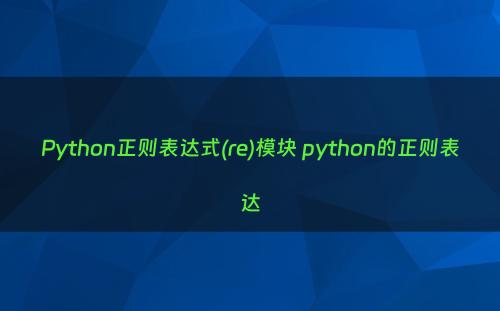网站首页 > 基础教程 正文
语法
| 意义 | 说明 |
"." | 任意字符 | |
"^" | 字符串开始 | '^hello'匹配'helloworld'而不匹配'aaaahellobbb' |
"$" | 字符串结尾 | 与上同理 |
"*" | 0 个或多个字符(贪婪匹配) | <*>匹配<title>chinaunix</title> |
"+" | 1 个或多个字符(贪婪匹配) | 与上同理 |
"?" | 0 个或多个字符(贪婪匹配) | 与上同理 |
*?,+?,?? | 以上三个取第一个匹配结果(非贪婪匹配) | <*>匹配<title> |
{m,n} | 对于前一个字符重复m到n次,{m}亦可 | a{6}匹配6个a、a{2,4}匹配2到4个a |
{m,n}? | 对于前一个字符重复m到n次,并取尽可能少 | ‘aaaaaa’中a{2,4}只会匹配2个 |
"\\" | 特殊字符转义或者特殊序列 | |
[] | 表示一个字符集 | [0-9]、[a-z]、[A-Z]、[^0] |
"|" | 或 | A|B,或运算 |
(...) | 匹配括号中任意表达式 | |
(?#...) | 注释,可忽略 | |
(?=...) | Matches if ... matches next, but doesn't consume the string. | '(?=test)' 在hellotest中匹配hello |
(?!...) | Matches if ... doesn't match next. | '(?!=test)' 若hello后面不为test,匹配hello |
(?<=...) | Matches if preceded by ... (must be fixed length). | '(?<=hello)test' 在hellotest中匹配test |
(?<!...) | Matches if not preceded by ... (must be fixed length). | '(?<!hello)test' 在hellotest中不匹配test |
.re的正则表达式语法
正则表达式语法表如下:
特殊序列符号 | 意义 |
\A | 只在字符串开始进行匹配 |
\Z | 只在字符串结尾进行匹配 |
\b | 匹配位于开始或结尾的空字符串 |
\B | 匹配不位于开始或结尾的空字符串 |
\d | 相当于[0-9] |
\D | 相当于[^0-9] |
\s | 匹配任意空白字符:[\t\n\r\r\v] |
\S | 匹配任意非空白字符:[^\t\n\r\r\v] |
\w | 匹配任意数字和字母:[a-zA-Z0-9] |
\W | 匹配任意非数字和字母:[^a-zA-Z0-9] |
正则表达式特殊序列表如下:
3.re的主要功能函数
常用的功能函数包括:compile、search、match、split、findall(finditer)、sub(subn)
compile
re.compile(pattern[, flags])
作用:把正则表达式语法转化成正则表达式对象
flags定义包括:
re.I:忽略大小写
re.L:表示特殊字符集 \w, \W, \b, \B, \s, \S 依赖于当前环境
re.M:多行模式
re.S:’ . ’并且包括换行符在内的任意字符(注意:’ . ’不包括换行符)
re.U: 表示特殊字符集 \w, \W, \b, \B, \d, \D, \s, \S 依赖于 Unicode 字符属性数据库
更多用法可以在http://www.devexception.com/sitemap_index.xml上查找
search
re.search(pattern, string[, flags])
search (string[, pos[, endpos]])
作用:在字符串中查找匹配正则表达式模式的位置,返回 MatchObject 的实例,如果没有找到匹配的位置,则返回 None。
match
re.match(pattern, string[, flags])
match(string[, pos[, endpos]])
作用:match() 函数只在字符串的开始位置尝试匹配正则表达式,也就是只报告从位置 0 开始的匹配情况,而 search() 函数是扫描整个字符串来查找匹配。如果想要搜索整个字符串来寻找匹配,应当用 search()。
下面是几个例子:
例:最基本的用法,通过re.RegexObject对象调用
1 #!/usr/bin/env python
2 import re
3 r1 = re.compile(r'world')
4 if r1.match('helloworld'):
5 print'match succeeds'
6 else:
7 print'match fails'
8 if r1.search('helloworld'):
9 print'search succeeds'
10 else:
11 print'search fails'
说明一下:r是raw(原始)的意思。因为在表示字符串中有一些转义符,如表示回车'\n'。如果要表示\表需要写为'\\'。但如果我就是需要表示一个'\'+'n',不用r方式要写为:'\\n'。但使用r方式则为r'\n'这样清晰多了。
例:设置flag
12 #r2 = re.compile(r'n

